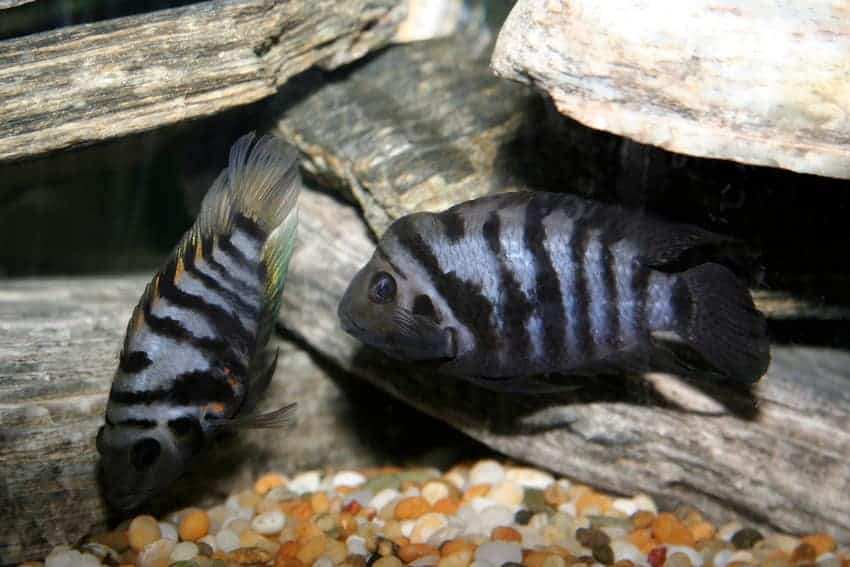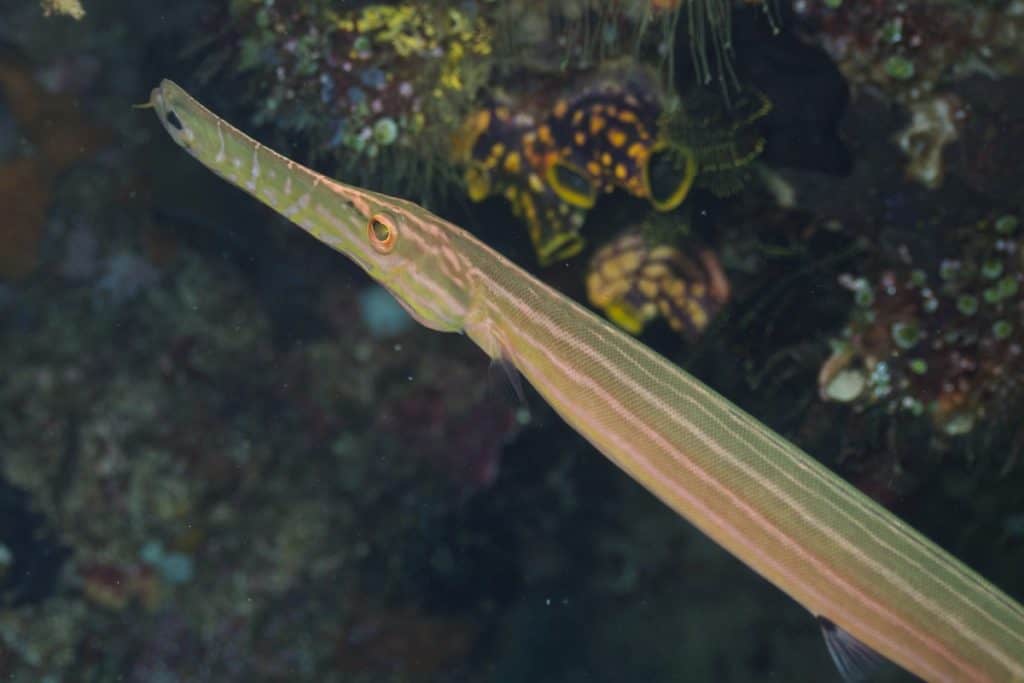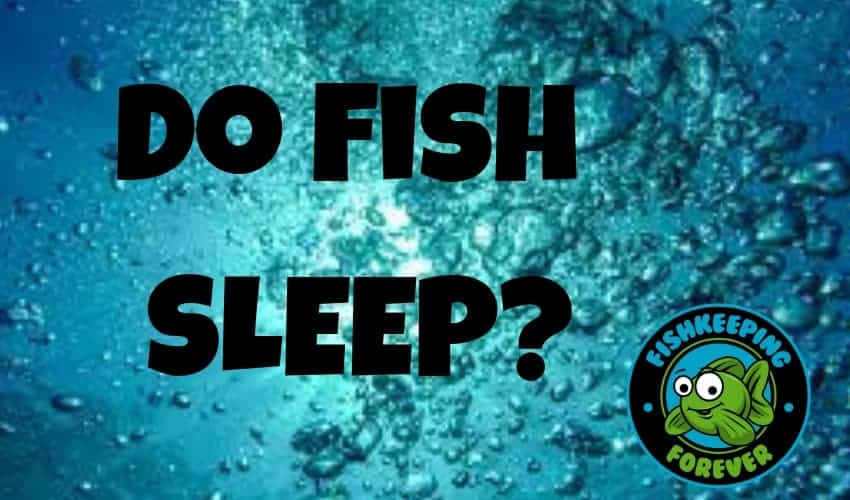Recently, there has been some noticeable burning curiosity regarding the sleeping abilities of fish. I have seen the question ‘ Do fish Sleep‘ recently in many tropical fish forums and facebook groups. To answer this, research has proven that fish don’t follow the literal definition of sleep.
To qualify as sleeping organisms they need to close their eyes. Moreover, the neocortex which is responsible for higher functions including sensory perception and generation of motor commands should not be active at that time.
Furthermore, specific electrical patterns should be distinguishably noticeable on an electroencephalograph (EEG).
Do fish sleep? For any creature to sleep they need to have eyes that close. The differing anatomy of fish means that they neither possess a neo-cortex nor do they have eyelids. Therefore, they are outside the realm that defines sleep. Fish do however rest and often fall into a dream-like state but in the true term of sleeping, fish do not sleep.
Owing to the drastic difference in the complexity and composition of fish brains, they do not experience transitions in sleep stages. Hence, they don’t experience the Rapid Eye Movement (REM) sleep. This phase of sleeping is the deep-sleep stage when most organisms experience dreams.
Although, the blue-headed wrasse and Spanish hogfish do drift off into a very deep dormancy phase, to the extent that one can lift them up and out without waking them.
Table of Contents
Fish can control their cardiac rhythms
Also, unlike most organisms, they have high control over their cardiac rhythms. They can arrange their nighttime and daytime rituals depending on the availability of food.
Other factors include the surrounding temperature, migration patterns and the possibilities of predators lurking around. This predisposition of being able to detect danger is unique to these marine creatures; by keeping their wits about them even while dozing, they can avoid perilous attacks.
Tautog Wrasse is the only on-the-go fish during the day in summers. However, upon tampering with temperature and photoperiod to emulate an autumn-like ambiance, they become active almost all the time with minimal sleep.
This is because naturally adult wrasse usually migrates offshore to overwinter.
Can Water Temperature play a part in fish sleeping?
As mentioned earlier, the temperature does directly correlate to levels of vigilance. In cold temperatures, Arctic Salmon leave their shelters in lesser frequency but still come out at night. This displays nocturnal tendencies as cold salmon react less quickly to aggressors because of their metabolism levels nose-diving.
Similarly, the reduction in mercury causes them to increase nocturnal tendencies. This particularly helps them to not become victims of diurnal warm-blooded predators like birds.
Following a shift in temperatures, the salmon then reverts to becoming more diurnal to collect sustenance.

Fish do, however, practice an alternative method of restoration in the form of daily periods of rest.
These are signified by the gradual decrease in their metabolism to an almost stagnant point, diminished activity levels, decelerated heartbeat, sluggish movement, and their negligible response to most stimuli (regardless they are at some conscious level still aware of their surroundings due to high sensitivity, unlike human beings).
Surface fishes sleep an average of over 800 minutes. Meanwhile, their counterpart cavefish only sleep an average ranging from 110 to 250 minutes.
This open-eye and a coma-like state can appear to humans as the fish zoning out of reality. Whereas, this is the way they refuel.
As such, they do fulfill certain sleep prerequisites that include maintaining a high arousal threshold, behavioral quiescence which is essentially them powering down, reversibility i.e. they can come back to a state of consciousness and that they exhibit certain routine sleeping posture all within a 24-hour window.
Fish sleep like no other creature
According to The National Sleep Foundation, due to the aforementioned reasons, fish sleep has earned a classification of its own as that of a daydreaming state. These water dwellers demonstrate actions that align themselves to those akin to that of hibernation.
This conclusion was also a product of an observational study that was conducted in 1961. Back in the day, European Public Aquaria gathered up to 200 species of fish that were used as a generalizable sample to study Fish Sleeping Patterns and Theories. The results suggest that they do indeed possess elements of overt sleeping modes.
Like other organisms, their version of suspended animation aims to serve as a recuperating mechanism as well. However, there are exceptions to this general rule due to limited sensory stimuli and brains that do not exhibit the need for sleep; such as fish swimming in shoals through featureless water, deep-water fish, or blind cavefish.
Cavefish populations like Tinaja, Molino, and Pachon are fatalities of sleeplessness as an outcome of evolutionary change.
Pelagic (Open Ocean) fish are those such as mackerel, tuna, bluefish, and some sharks. Since it flutters through the water nonstop and is open to responding and receiving stimuli.
In extenuating circumstances like spawning, migrating, or safeguarding of nests or their young, fish like bullheads, many species of minnow, yellow perch, and bass do not take a time-out either.

Convict Cichlids females, damselfishes, threespine sticklebacks, brown bullhead, and bass (largemouth and smallmouth) endlessly fan their eggs to supply a steady oxygenated supply; thus, sacrificing their resting period.
An exception to the spawning example is the diurnal convict cichlids. Even with the lights off they continue to spawn and lay eggs.
What’s the purpose of sleep?
The basic purpose of sleep is to form memories and to process sensory inputs. Therefore, fishes that swim continuously or ones that swim in regions that lack sensory provocations don’t exhibit the tendency to get some shut-eye.
Some don’t even sleep until they mature to adulthood. Including the Mozambique Tilapia, that for the first 22 weeks of existence does not rest at all. In schools of fish a portion of the members’ repose, whilst the remaining few stand guard over them.
These roles are interchangeably switched between members. White suckers display traits of diurnal creatures when they live in shoals but on their own appear to act nocturnal.
The behaviors displayed are extremely varied in each species. Several factors influence the behavior of these aquatic species Factors such as their individual activity levels, location, and the surrounding environment.
These vary in what positions they take up, their ability to respond to external stimuli and the exact resting time duration.
The patterns range from locating and establishing a suitable nest, hiding in caves or corals, burrowing into mud or coral, settling down in the substrate or even simply floating in place with sporadic fin movement to maintain balance and to keep the ventilation i.e. the flow of oxygen to keep their gills active.
Sharks move relatively more, but at a similarly slower rate whilst napping. There are certain shark species that are able to cease swimming via the facility of buccal-pumping.
This means that water continuously washes over their gills regardless of their motionless state. Another interesting characteristic of sharks is their possession of eyelids.
Do fish have sleep or rest patterns?
The Betta fish is an ideal example of a frequent sleeper that follows human sleep patterns. This translates into resting during nighttime by finding a secure place to lay low.
Most surface fish are diurnal since they also imitate socially acceptable routines of activity during the day and inactivity at night. This is mainly derived from their basic survival instinct; the possession of sharp eyesight during the daylight hours allows them to scour for nourishment.
While at night-time, they take a break when their eyes are naturally less effective. Fish that reside near coral reefs also follow a similar schedule to evade threats.
In artificial settings, the lights present inside the aquarium help in the manipulation of a fish’s sleep cycle. Therefore, once the lights are switched off, it acts as a signal to the fish to doze-off into a trance-like state.
This goes on until either the lights are switched back on or if an external trigger jolts them awake. Hence, if a fish tank is occupied by tilapia, minnow, brown bullhead or coral reef fish, they adapt their slumber timings in accordance with the lights. The Green Chromis is a reef species that has instinctively evolved a nocturnal mutualistic relationship.
This type of behavior is most commonly and easily observable in the favored house pet, Goldfish. After sundown, somnolence-influenced mannerisms become apparent. So, they slip into what we refer to as a nap. They do so by sinking down to hover near the lowest water level of the aquarium.
Generally, their activity levels dip to negligible, apart from tiny correcting motions by their fins to maintain a stable swimming motion.
Thus, at this point when you sprinkle food into the tank, you will notice a delay in the response to the feeding. It is because they’re not completely awake to register what is going on.
One can even find fish that modify their physical appearances when filled with excitement. Particularly, it depends upon their environment and stage of their lifecycle.
Such examples include the Moki and Trumpeter fish which can transform their color patterns in sync with day and night.

One could make an analogical reference to these as similar to humans changing out of their work clothes into sleep clothes. There are exceptions of course; numerous species that follow a nocturnal lifestyle like the swell shark or the California horn shark which hides during the day and eats in the evening.
Do fish suffer from insomnia?
Uncharacteristically fish do share one likeness to Homo Sapiens which is suffering from isolated cases of insomnia. Experts and researchers have been able to present data that indisputably proves that Zebra Fish do sleep.
Moreover, they can undergo conditions of sleep deprivation. Zebra Fish lack Orexin (hypocretin receptors) which plays an essential role in the central feedback mechanism.
These are responsible for sleep-wake controls and also strongly influence the regulation of stress, reward, and metabolism.
In everyday occurrence, zebrafish lower their tails and descend beneath the water surface to enter a dormant phase. Movements of their mouths and gills decrease in frequency by up to fifty percent.
Waking them up also seems to be a tough feat to accomplish. They hover either with their heads raised slightly or horizontally.
They achieved this monumental feat through experimentation, by employing a method of repeatedly disturbing the fish with the use of mild and non-life-threatening electrical shocks. Thus, the shocks were a source of sleep prevention causing the fishes to stay awake for extended periods of time.
Consequently, the test subjects showed a highly pronounced rebound effect. The ones that were forcibly kept roused throughout the night jumped at the opportunity to make up on lost time.
When left in peace in a dark environment, observation shows them catching up on their sleep by snoozing even more.
This behavior was only portrayed if the surroundings were dimly lit. Not if there was a light present to obstruct their bedtime.
Some fish create their own bed
A lot of the Parrot Fish species like the princess parrotfish in the Caribbean Reef has historically brought forth an almost traditional human-like sleeping talent. They have a knack of creating their very own sleeping bags that are cocoon-like in nature.
They do so by secreting mucus. It’s a jelly-like substance secreted from the glands near their gills when there is some energy depletion.
This exterior covering encompasses their entire body and tucks them inside; thereby, providing a reliable shield between them and any possible enemies such as gnathiids parasites. The whole process takes about 45-60 minutes to achieve.
The Pacific Sand Lance burrow into the sand to conserve their energy and Goldfish sink lower down water levels to sleep. The Brown Bullhead Catfish rests in an inclined position of 10-20 degree vertical angles along the substrate.
Whilst in this pose their fins are stretched out and tails are flattened on the ground. Their cardiac rhythms and respiratory rhythms were also functioning at below-average levels.
Furthermore, they were immune to tactile and audio stimulations such as being poked with a glass rod.
Mozambique Tilapias during nighttime rest at the bottom of the aquarium. Also, their rate of respiration drops significantly. They seemingly refuse to respond obviously to probing via food delivery or electrical current at night as compared to mornings.
Furthermore, they don’t present detectable eye movements. There are a lot of fishes that provide no responses to any interruptions like wrasse, requiem sharks, and Tautogolabrus adspersus.
Hence, it is safe to say that fishes are nearly identical to any other living organism. This means that they require intervals of respite from physical and psychological functioning.
At the end of the day, even an upside-down jellyfish lacking brains experiences episodes of inactivity, nonexistent stimulus-response, and signs of sleep deprivation.
Conclusion: Do fish sleep?
We can say that fish do not sleep like humans but definitely sleep in a dream-like state which could be classed as sleeping. My other thought is ‘ Do fish dream?’ and if they do what do you think they dream about.
We’ll leave that question for another day.
- Comparing Aquarium Gravel To Sand – Which Is Best For Your Tank?
- Silver Arowana: Complete, Care, Breeding, Feeding Guide
- Rainbow Shark: Diet | Size | Breeding | Cost
- Tiger Barb Fish: Diet | Breeding | Size | Water Conditions
- Jack Dempsey: Diet | Size | Breeding | Lifespan | Sexing | Care Guide

I have been working in the tropical fish industry for over 30 years now and I’m still learning. Everyday is a school day in this hobby. In my spare time I play golf very badly!


